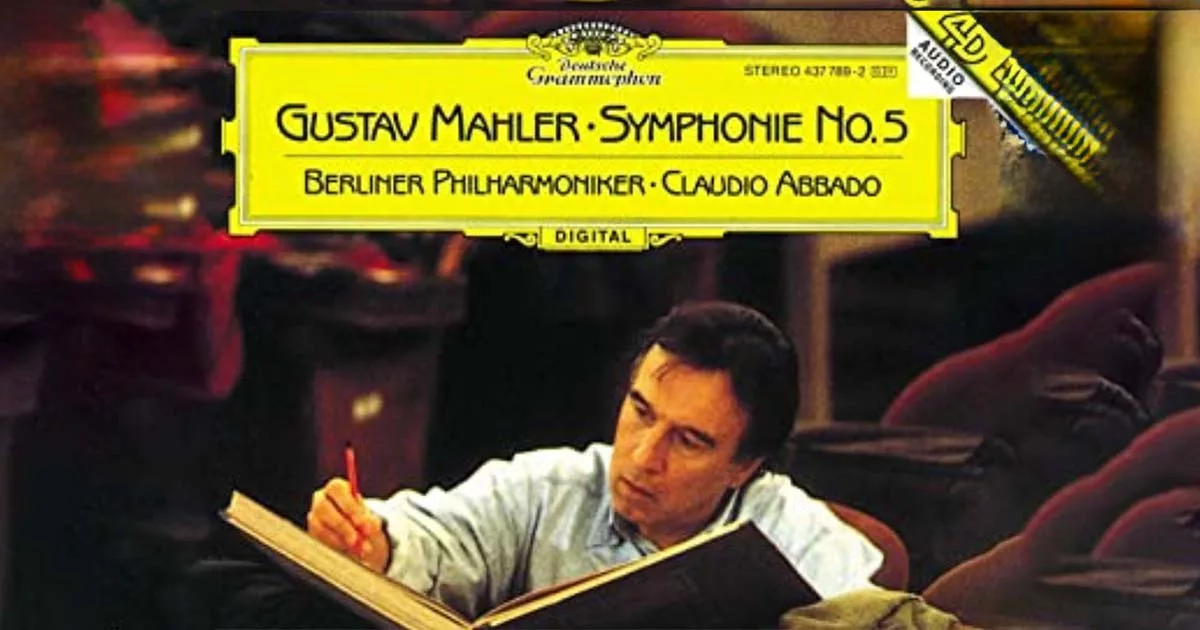Mahler’s 5th Symphony: As someone who loves classical music, I’m always searching for new artists and recordings to discover. If you’re a fan of the Berlin Philharmonic or a Mahler enthusiast, then you’re in for a treat! This recording showcases the incredible talent of the Berlin Philharmonic, one of the world’s finest orchestras, and Abbado’s masterful interpretation of Mahler’s music. Fellow Streamer will tell you all about it here!
Introduction Mahler’s 5th Symphony
The Berlin Philharmonic is one of the world’s most renowned orchestras for its virtuosity, precision, and emotional depth. Founded in 1882, the orchestra has a long and storied history. It has been led by some of the greatest conductors of all time, including Wilhelm Furtwängler, Herbert von Karajan, and Claudio Abbado.
Claudio Abbado is a conductor of immense talent and skill. He deeply understands classical music, and his interpretations of works by composers such as Mahler, Beethoven, and Schubert are widely regarded as some of the best ever recorded. Abbado is also known for his ability to draw the best out of orchestras, and his collaboration with the Berlin Philharmonic is no exception.

Who was Gustav Mahler?
Gustav Mahler was a composer and conductor of the late Romantic era and one of the leading figures of his time. Born in 1860 in Bohemia, Mahler began his musical career as a conductor, working at various theatres and opera houses throughout Europe. However, as a composer, Mahler made his greatest impact, creating a series of large-scale works that are now considered some of the most important pieces of the late Romantic era.
Mahler’s music is notable for its grand scale and emotional intensity, blending classical structures with sweeping melodies, rich harmonies, and powerful rhythms. His works often draw upon a wide range of musical styles and influences, from the traditional folk music of his native Bohemia to the grandeur of classical music and the beauty of the natural world.

Mahler’s Symphony No. 5 is one of his most famous works and is widely regarded as one of the greatest pieces of classical music ever composed. This powerful composition showcases Mahler’s mastery of orchestration and his ability to evoke a wide range of emotions through his music. From the sombre opening theme to the joyful conclusion, Symphony No. 5 is a true tour de force and a testament to Mahler’s genius as a composer.
Overview of A Timeless Masterpiece
Gustav Mahler’s Symphony No. 5 is a complex and emotionally charged composition that has captured the hearts and imaginations of audiences for over a century. The work was composed in 1901 and 1902, reflecting the tumultuous period of Mahler’s life during which he grappled with personal and professional challenges.
The symphony is widely considered to be one of Mahler’s most personal works, and it is said to be a reflection of his internal struggles and the complex emotional landscape of his life at the time. Some have interpreted the work as a musical representation of the five stages of grief, with each movement corresponding to a different stage.
Despite the dark and brooding nature of much of the music, the symphony is not without moments of beauty and hope. The first movement opens with a sombre and mournful theme, which is then transformed into a joyful and uplifting melody. Throughout the rest of the symphony, Mahler explores a wide range of moods and emotions, from tender love songs to powerful chorales.
Mahler’s Symphony No. 5 is a work of many contrasts. It is simultaneously beautiful and brooding, full of haunting melodies and powerful moments. The first movement opens with a sombre and mournful theme, which is then transformed into a joyful, uplifting melody.
Throughout the rest of the symphony, Mahler explores various moods and emotions, from tender love songs to powerful chorales. This emotional diversity is what makes Symphony No. 5 such a rich and rewarding experience for listeners.
Mahler’s 5th Symphony Structure
The symphony is divided into five movements, with each movement showcasing a different aspect of Mahler’s musical style and philosophy.
The first movement, “Trauermarsch,” is a funeral march that opens the work with a sense of mourning and sadness. This movement is characterized by its sombre and mournful theme, played by the strings and later repeated by the winds and brass. The music of this movement builds to a powerful climax before subsiding into a soft and mournful conclusion.

The second movement, “Stürmisch bewegt,” is a scherzo that contrasts the mournful first movement with a fast and lively theme. This movement is characterized by its playful and energetic rhythms, which are punctuated by sharp and staccato chords from the strings. The music of this movement is light and playful, contrasting to the sombre first movement.
The third movement, “Scherzo,” is a scherzo in a traditional classical form. This movement is characterized by its bright and energetic theme, played by the strings and later repeated by the winds and brass. The music of this movement is playful and energetic, contrasting to the sombre first and second movements.
The fourth movement, “Adagietto,” is a slow and contemplative movement that serves as a prelude to the final movement. This movement is characterized by its soft and mournful theme, played by the strings and later repeated by the winds and brass. The music of this movement builds to a powerful climax before subsiding into a soft and mournful conclusion.
The conclusion of Gustav Mahler’s Symphony No. 5 is embodied in the lively and dynamic “Rondo-Finale.” This movement showcases a buoyant and energetic melody, initially introduced by the strings and later echoed by the winds and brass.
The music is marked by a lively and playful demeanour, contrasting the melancholic tone of the preceding first, second, and fourth movements. The “Rondo-Finale” brings the symphony to a thrilling and exuberant end, leaving a lasting impression on the listener.
Thoughts about it
The first movement opens with a sombre and mournful theme, which is then transformed into a joyful, uplifting melody. Throughout the rest of the symphony, Mahler explores a range of contrasts, from tender love songs to powerful chorales. This emotional diversity is what makes Symphony No. 5 so rich and rewarding for listeners.
The intricate structure of Symphony No. 5 is a testament to Mahler’s skill as a composer. The use of themes and motifs throughout the work helps to bind the various movements together, creating a unified whole that is greater than the sum of its parts.
One of the most notable features of the symphony is the extensive use of brass instruments. The brass section plays a prominent role in the work, from the powerful opening fanfare to the triumphant brass chorales. This adds a sense of grandeur and majesty to the symphony, making it a truly epic listening experience.
The Berlin Philharmonic
A World-Class Orchestra
The Berlin Philharmonic is one of the most celebrated orchestras in the world, renowned for its virtuosity, precision, and emotional depth. Founded in 1882, the orchestra has a long and storied history and has been at the forefront of the classical music world for over a century.

Over the years, the Berlin Philharmonic has been led by some of the greatest conductors of all time, including Wilhelm Furtwängler, Herbert von Karajan, and Claudio Abbado. These legendary conductors have helped to shape the sound and style of the Berlin Philharmonic and have made it one of the most sought-after orchestras in the world.
Why is The Berlin Philharmonic well Known?
The Berlin Philharmonic is known for its virtuosity and precision. The musicians of the orchestra are all highly trained and skilled, and they have a deep understanding of the music they play. Whether they are playing the works of Beethoven, Mozart, or Mahler, the Berlin Philharmonic always delivers a technically precise and emotionally charged performance.
But what truly sets the Berlin Philharmonic apart from other orchestras is its emotional depth.
The musicians of the Berlin Philharmonic bring a unique level of passion and intensity to every performance, and they can convey the emotional content of the music in a powerful and moving way. Whether they are playing a beautiful love song or a powerful chorale, the Berlin Philharmonic always manages to touch the hearts of its listeners.
Claudio Abbado
A Maestro of Classical Music
Claudio Abbado was a conductor of exceptional talent and skill. His deep understanding of classical music and his unique interpretations of works by composers such as Mahler, Beethoven, and Schubert earned him a reputation as one of the most highly regarded conductors of all time.
Claudio Abbado history
Born in Milan, Italy, in 1933, Abbado began his musical career as a pianist but soon discovered that his true calling was in conducting. After studying at the Milan Conservatory, he went on to lead some of the world’s most prestigious orchestras, including the La Scala Philharmonic, the London Symphony Orchestra, and the Vienna Philharmonic.
Abbado’s talent as a conductor was widely acknowledged, with many praising his ability to bring out the best in orchestras. He possessed a rare gift for creating a sense of unity and cohesion within the ensemble, and his interpretations were renowned for their emotional depth and nuance. He was also recognized for his ability to highlight the music’s beauty through a powerful crescendo or a tender moment.

Claudio Abbado passed away on January 20, 2014, at the age of 80. He had suffered from ill health for several years before his death, but he continued to conduct and perform until shortly before his passing.
Abbado’s legacy as one of the great conductors of his generation was solidified through his musical talent, passion for opera and classical music, and commitment to musical education. The classical music community mourned his death, and his contributions to the music world continue to be celebrated and remembered to this day.
Abbado’s greatest strength
Abbado’s greatest strength as a conductor was allowing the music to speak for itself. He deeply understood the composer’s intent and could communicate this to the orchestra, resulting in technically precise and emotionally charged performances.
In the case of Symphony No. 5, Abbado’s interpretation was nothing short of spectacular. He brought out Mahler’s music’s emotional depth and complexity, making this recording a true classical music masterpiece.
Whether you were a fan of classical music or simply seeking a powerful and emotional listening experience, Abbado’s interpretation of Symphony No. 5 was not to be missed.
The Berlin Philharmonic
Records Mahler’s 5th Symphony (1993)
The Berlin Philharmonic and Claudio Abbado’s recording of Gustav Mahler’s Symphony No. 5 was a true triumph of classical music. The level of technical precision and emotional depth achieved in this performance was simply stunning, and it was a testament to the musicians and conductor’s talent and skill.
The 1992-1993 recording of Gustav Mahler’s Symphony No. 5 by the Berlin Philharmonic Orchestra under the direction of Claudio Abbado was released by Deutsche Grammophon. It was recorded in the Philharmonie Berlin and is part of Abbado’s complete recording of Mahler’s symphonies with the Berlin Philharmonic.
The recording features the use of period instruments and a romantic interpretation of the work, typical of Abbado’s approach to Mahler’s music. The recording received positive reviews from critics and is considered one of the finest interpretations of Symphony No. 5 by many music lovers.
The playing of the Berlin Philharmonic was rich and nuanced, with each note and phrase crafted with the utmost care. The musicians brought passion and artistry to the breathtaking performance, and it was easy to see why they were regarded as one of the world’s most renowned orchestras.
Abbado’s interpretation of Symphony No. 5 was nothing short of masterful. He deeply understood Mahler’s music, and his approach brought out the best in the musicians and the work itself. The result was a technically precise and emotionally charged performance, with every note and phrase imbued with meaning and depth.

Conclusion
Gustav Mahler’s Symphony No. 5 is a game-changer in classical music! This intense and emotional masterpiece is one of the most complex and challenging works of all time, and only a true maestro can bring it to life. That’s why Claudio Abbado’s interpretation of Symphony No. 5 is so incredible! He’s got the talent, skills, and deep understanding of classical music that makes his performances unforgettable.
Symphony No. 5 is a rollercoaster of emotions! From beautiful love songs to powerful chorales, this symphony is a thrilling journey through various feelings. It’s what makes it so captivating and exciting to listen to! And with Abbado at the helm, it’s like experiencing the work in a whole new light.
The Berlin Philharmonic brings their A-game to this performance, playing with richness, nuance, and raw passion. Abbado brings out the best in the musicians and the music, making this recording an unforgettable experience. Get ready to be blown away by the technical precision and emotional depth of Abbado’s interpretation of Symphony No. 5!
This recording of Mahler’s Symphony No. 5 was truly a once-in-a-lifetime experience. It was a must-listen for classical music fans and anyone looking for a powerful and emotional musical journey.
So, it’s time to put on your headphones and immerse yourself in the beauty and power of one of the greatest works of classical music, as performed by the Berlin Philharmonic and Claudio Abbado. You can stream it on all the major platforms, but I truly recommend it on Apple Music, Lossless.
Read the review about the intriguing soundtrack of “All Quite on the western front.”
And visit the Home page for more content!










